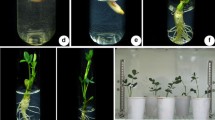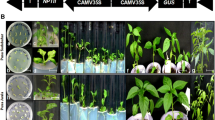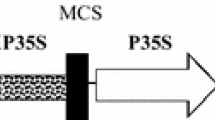Abstract
Morphologically normal and fertile transgenic plants of mungbean with two transgenes, bar and α-amylase inhibitor, have been developed for the first time. Cotyledonary node explants were transformed by cocultivation with Agrobacterium tumefaciens strain EHA105 harboring a binary vector pKSB that carried bialaphos resistance (bar) gene and Phaseolus vulgaris α-amylase inhibitor-1 (αAI-1) gene. Green transformed shoots were regenerated and rooted on medium containing phosphinothricin (PPT). Preculture and wounding of the explants, presence of acetosyringone and PPT-based selection of transformants played significant role in enhancing transformation frequency. Presence and expression of the bar gene in primary transformants was evidenced by PCR-Southern analysis and PPT leaf paint assay, respectively. Integration of the Phaseolus vulgaris α-amylase inhibitor gene was confirmed by Southern blot analysis. PCR analysis revealed inheritance of both the transgenes in most of the T1 lines. Tolerance to herbicide was evidenced from seed germination test and chlorophenol red assay in T1 plants. Transgenic plants could be recovered after 8–10 weeks of cocultivation with Agrobacterium. An overall transformation frequency of 1.51% was achieved.




Similar content being viewed by others
Abbreviations
- BAP:
-
6-Benzylaminopurine
- IBA:
-
Indole-3-butyric acid
- B5 :
-
Gamborg's medium (1968)
- bar :
-
Bialaphos resistance
- αAI :
-
α-Amylase inhibitor
- PPT:
-
Phosphinothricin.
References
Aragao FJL, Sarokin L, Vianna GR, Rech EL (2000) Selection of transgenic meristematic cells utilizing a herbicide molecule results in the recovery of fertile transgenic soybean [Glycine max (L.) Merril] plants at a high frequency. Theor Appl Genet 101:1–6
Atkinson RG, Gardner R (1991) Agrobacterium-mediated transformation of pepino and regeneration of transgenic plants. Plant Cell Rep 10:208–212
Banto SM, Sanchez FF (1972) The biology and chemical control of Callosobruchus chinensis (Linn.) (Coleoptera: Bruchidae). Philipp Entomol 2:167–182
Baron C, Zambryski PC (1995) The plant response in pathogenesis, symbiosis and wounding: variations on a common theme. Ann Rev Genet 29:107–129
Bean SJ, Gooding PS, Mullineaux P, Davies DR (1997) A simple system for pea transformation. Plant Cell Rep 16:513–516
Bidney D, Scelonge C, Martich J, Burrs M, Sims L, Huffman G (1992) Microprojectile bombardment of plant tissues increases transformation frequency by Agrobacterium tumefaciens. Plant Mol Biol 18:301–313
Binns AN, Thomashow MF (1988) Cell biology of Agrobacterium infection and transformation of plants. Ann Rev Microbiol 42:575–606
Brukhin V, Clapham D, Elfstrand M, Arnold SV (2000) Basta tolerance as selectable and screenable marker for transgenic Norway spruce. Plant Cell Rep 19:899–903
Chhabra KS, Kooner BS (1980) Research on Kharif pulses. In: Annual Progress Report of Pulse Research Workers Workshop, CAUAT, Kanpur, India
Chilton MD, Carrier TC, Farrand SK, Bendich AJ, Gordon MP, Nester EW (1974) Agrobacterium tumefaciens DNA and PS8 bacteriophage DNA not detected in crown gall tumors. Proc Natl Acad Sci USA 71:3672–3676
Fillippone E (1993) To improve resistance against diseases and pests. Grain Legumes 2:20–21
Gamborg OL, Miller RA, Okajima K (1968) Nutrient requirements of suspension cultures of soybean root cells. Exp Cell Res 50:151–156
Godwin I, Todd G, Ford-Lloyd B, Newbury H J (1991) The effect of acetosyringone and pH on Agrobacterium-mediated transformation vary according to plant species. Plant Cell Rep. 9:671–675
Grant JE, Cooper PA, McAra EA, Frew TJ (1995) Transformation of peas (Pisum sativum) using immature cotyledons. Plant Cell Rep 15:254–258
Grant JE, Cooper PA, Gilpin BJ, Hoglund SJ, Reader JK, Pither Joyce MD, Timmerman-Vaughan GM (1998) Kanamycin is effective for selecting transformed peas. Plant Sci 139:159–164
Gulati A, Jaiwal PK (1990) Culture conditions affecting plant regeneration from cotyledon of Vigna radiata L. Wilczek. Plant Cell Tiss Org Cult 23:1–7
Gulati A, Jaiwal PK (1992) In vitro induction of multiple shoots and plant regeneration from shoot tips of mungbean (Vigna radiata L. Wilczek). Plant Cell Tiss Org Cult 29:199–205.
Gulati A, Jaiwal PK (1994) Plant regeneration from cotyledonary node explants of mungbean (Vigna radiata (L.) Wilczek). Plant Cell Rep 13:523–527
Hess D, Dressler K, Nimmrichter R (1990) Transformation experiments by pippetting Agrobacterium into the spikelets of wheat (Triticum aestivum L.). Plant Sci 72:233–24
Ishimoto M, Sato T, Chrispeels MJ, Kitamura K (1996) Bruchid resistance of transgenic azuki bean expressing seed alpha-amylase inhibitor of common bean. Entomol Exp Appl 79:309–315
Jaiwal PK, Kumari R, Ignacimuthu S, Potrykus I, Sautter C (2001) Agrobacterium tumefaciens-mediated genetic transformation of mungbean (Vigna radiata L. Wilczek)--a recalcitrant grain legume. Plant Sci 161:239–247
Jaiwal PK, Singh RP (eds) (2003) Focus on biotechnology. In: Improvement strategies for leguminosae biotechnology, vol 10A. Kluwer, Dordrecht
Janssen BJ, Gardner RC (1993) The use of transient GUS expression to develop on Agrobacterium-mediated gene transfer system for kiwifruit. Plant Cell Rep 13:28–31
Jefferson RA, Kavanagh TA, Bevan M (1987) GUS fusions: beta-glucuronidase as a sensitive and versatile gene fusion marker in higher plants. EMBO J 6:3901–3907
Jeswani LM, Baldev B (1990) Advances in pulse production technology. Publication and Information Division, Indian Council of Agricultural Research, New Delhi
Kaneyoshi J, Kobayashi S, Nakamura Y, Shigemoto N, Doi Y (1994) A simple and efficient gene transfer system of trifoliate orange. Plant Cell Rep 13:541–545
Khalafalla MM, El-Shemy HA, Mizanur RS, Teraishi M, Teraishi M, Ishimoto M (2005) Recovery of herbicide resistant Azuki bean [Vigna nagularis (Wild.), Ohwi & Ohashi] plants via Agrobacterium-mediated transformation. Afr J Biotechnol 4(1):61–67
Khan MRI, Tabe LM, Heath LC, Spencer D, Higgins TJV (1994) Agrobacterium tumefaciens-mediated transformation of subterranean clover (Trifolium subterraneaneum L). Plant Physiol 105:81–88
Kolar JS, Dhingra KK (1986) Control weeds in mungbean. Indian Farm 35:27
Kuai B, Dalton SJ, Bettany AJE, Morris P (1999) Regeneration of fertile transgenic tall fescue plants with a stable highly expressed foreign gene. Plant Cell Tiss Org Cult 58:149–154
Langridge P, Brettschneider R, Lazzeri P, Lorz H (1992) Transformation of cereals via Agrobacterium and the pollen pathway: a critical assessment. Plant J 2:631–638
Morton RL, Schroeder HE, Bateman KS, Chrispeels MJ, Armstrong E, Higgins TJV (2000) Bean α-amylase inhibitor 1 in transgenic peas (Pisum sativum) provides complete protection from pea weevil (Bruchus pisorum) under field conditions. Proc Natl Acad Sci USA 97:3820–3825
Murray MG, Thompson WF (1980) Rapid isolation of high molecular weight plant DNA. Nucl Acid Res 8:4321–4325
Orczyk AN, Orczyk W (2000) Study of the factors influencing Agrobacterium-mediated transformation of pea (Pisum sativum L.). Mol Breed 6:185–194
Pigeaire A, Abernethy D, Smith PM, Simpson K, Fletcher N, Lu Chin Yi, Atkins CA, Cornish E (1997) Transformation of a grain legume (Lupinus augustifolius L.) via Agrobacterium tumefaciens mediated gene transfer to shoot apices. Mol Breed 3:341–349
Puonti-Kaerlas J, Erikson T, Engstrom P (1990) Production of transgenic pea (Pisum sativum L.) plants by Agrobacterium tumefaciens-mediated gene transfer. Theor Appl Genet 80:246–252
Sahoo L, Sugla T, Jaiwal PK (2003) In vitro regeneration and genetic transformation of Vigna species. In: Jaiwal PK, Singh RP (eds) Focus on biotechnology, vol 10B. Applied genetics of leguminosae biotechnology. Kluwer, Dordrecht, pp 89–120
Saini R, Jaiwal PK (2002) Age, position in mother seedling, orientation and polarity of the epicotyl segments of blackgram (Vigna mungo L. Hepper) determines its morphogenic response. Plant Sci 163:101–109
Saini R, Jaiwal S, Jaiwal PK (2003) Stable genetic transformation of Vigna mungo L. Hepper via Agrobacterium tumefaciens. Plant Cell Rep 21:851–859
Sambrook J, Fritsch EF, Maniatis T (1989) Molecular Cloning: a laboratory manual. Cold Spring Harbor Press, New York
Sangwan RS, Bourgoies Y, Brow S, Vasseur G, Sangwan-Norreel BS (1992) Characterization of competent cells and early events of Agrobacterium-mediated transformation of Arabidopsis thaliana. Planta 188:439–456
Sarmah BK, Moore A, Tate W, Molvig L, Morton RL, Rees DP, Chiaiese P, Chrispeels MJ, Tabe LM, Higinns TJV (2004) Transgenic chickpea seeds expressing high levels of a bean α-amylase inhibitor. Mol Breed 14:73–82
Sarria R, Torres E, Angel F, Chavarriaga P, Roca WM (2000) Transgenic plants of cassava (Manihot esculenta) with resistance to Basta obtained by Agrobacterium-mediated transformation. Plant Cell Rep 19:339–344
Schroeder HE, Schotz AH, Wardley-Richardson T, Spencer D, Higgins TJV (1993) Transformation and regeneration of two pea cultivars (Pisum sativum L.). Plant Physiol 101:751–757
Schroeder HE, Gollasch S, Moore A, Tabe LM, Craig S, Hardie DC, Chrispeels MJ, Spencer D, Higgins TJV (1995) Bean α-amylase inhibitor confers resistance to the pea weevil (Bruchus pisorum) in transgenic pea (Pisum sativum L.). Plant Physiol 107:1233–1239
Shade RE, Schroeder HE, Pueyo JJ, Tabe LM, Murdock LL, Higgins TJV, Chrispeels MJ (1994) Transgenic pea seeds expressing the alpha amylase inhibitor of the common bean are resistant to bruchid beetles. Biotechnology 12:793–796
Stachel SE, Messens E, Van Montagu M, Zambryski P (1985) Identification of signal molecules produced by wounded plant cells that activate T-DNA transfer in Agrobacterium tumefaciens. Nature 318:624–629
Stachel SE, Nester EW, Zambryski P (1986) A plant cell factor induces Agrobacterium tumefaciens vir gene expression. Proc Natl Acad Sci USA 83:379–383
Tiyagi SA, Mashkoor Alam M (1992) Pulse cultivation in India: an overview. Everyman's Sci (June–July), pp 82–84
Treiu AT, Harrison MJ (1996) Rapid transformation of Medicago truncatula: regeneration via shoot organogenesis. Plant Cell Rep16:6–11
Villemont E, Dubois F, Sangwan-Norreel BS (1997) Role of host cell cycle in the Agrobacterium-mediated genetic transformation of Petunia: evidence of an S-phase control mechanism for T-DNA transfer. Planta 201:160–172
Wordragen MFV, Dons HJM (1992) Agrobacterium tumefaciens-mediated transformation of recalcitrant crops. Plant Mol Biol 5:299–302
Zhang Z, Xing A, Staswick P, Clemente TE (1999) The use of glufosinate as a selective agent in Agrobacterium-mediated transformation of soybean. Plant Cell Tiss Org Cult 56:37–56
Acknowledgements
We are grateful to the Department of Science and Technology, New Delhi for financial assistance. We are also thankful to Prof. M. J. Chrispeels, University of California, USA for the plasmid KSB harboring α-amylase inhibitor-1 and bar genes and to Prof. Anil Grover, University of Delhi South Campus, New Delhi for providing laboratory facilities for molecular biology work.
Author information
Authors and Affiliations
Corresponding author
Additional information
Communicated by D. A. Somers
Rights and permissions
About this article
Cite this article
Sonia, Saini, R., Singh, R.P. et al. Agrobacterium tumefaciens mediated transfer of Phaseolus vulgaris α-amylase inhibitor-1 gene into mungbean Vigna radiata (L.) Wilczek using bar as selectable marker. Plant Cell Rep 26, 187–198 (2007). https://doi.org/10.1007/s00299-006-0224-4
Received:
Revised:
Accepted:
Published:
Issue Date:
DOI: https://doi.org/10.1007/s00299-006-0224-4




